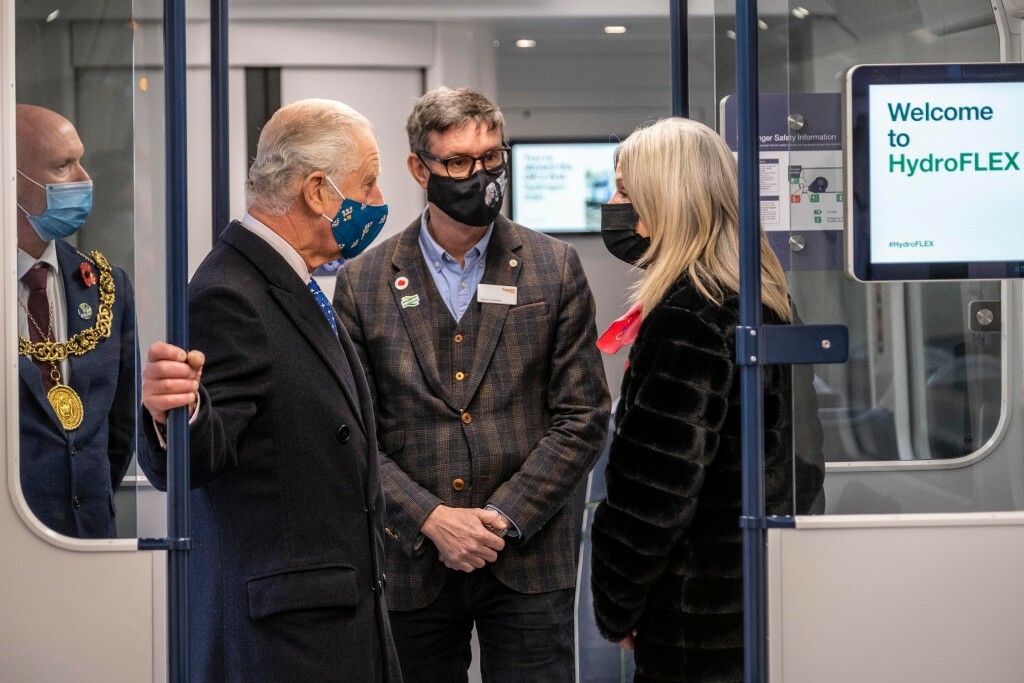CEO Mary Grant features in RailDirector
Originally published in RailDirector Magazine, December 2022
Mary Grant shares her story from farmer’s daughter to the chief executive officer of Porterbrook and her exciting plans to drive both the company and the rail industry forward.
Herding sheep in the hills of the Scottish borders and milking cows at 3am in the morning might feel like a world away from the hustle and bustle of the UK railway, but it was an experience that provided Mary Grant with the ideal platform for driving the rail industry forward today. The chief executive officer of Porterbrook is now a self-confessed train anorak but growing up all she had to get around was her push bike and the local bus service.
“It was never an aspiration to work in the railways when I was younger, but now I absolutely love trains, what they do, the service they provide and the support they give communities. Whether it was harvest or lambing, we relied on the support from the farming community at different times of the year. The UK railway is the same. Co-ordination is vital and if one part isn’t working then other areas of the system won’t function either. I’ve grown up with a sharing mentality and I have a firm view that collaboration is the only way to succeed.”
It is an ethos and philosophy which has served Mary well, particularly in her current role at railway asset owner and manager Porterbrook, which owns almost a quarter of the national passenger rail fleet and currently has around 4,000 vehicles on lease or on order. The route to chief executive officer hasn’t been straightforward and, in fact, Mary started her career in motorway service areas as a trainee wiping tables at Welcome Break’s South Mimms services. She advanced to the organisation’s marketing manager before being headhunted by National Express in
1997.
“My time at Welcome Break taught me the importance of looking after your people because it enhances both your business and adds value to the overall service which is being provided to customers.” she said. “Starting off as a graduate trainee I scrubbed floors for months on end and served on the tills. It wasn’t quite what I expected but it didn’t do me any harm either insofar as how not to treat your future leaders."
Changing track
Mary swapped the highway for the Permanent Way when she left her role as marketing manager at Welcome Break to become marketing director at North London Railways, responsible for the rebranding of Silverlink County and Metro.
“There were transferable skills with the emphasis in both industries on logistics and people. I saw the move as a great opportunity to go out and explore,” she said. “Although in a marketing environment I didn’t really consider the broader elements of the railway such as engineering dynamics, safety implications and operations. I was very much focussed on how to build revenue, drive yields, grow value and understand some of the black arts of the passenger demand handbooks.”
“It was a great entry into the railways and from that I was asked to do some work in Australia with National Express. The experiences started off my fascination with how train services support the wider economy by connecting communities. It was the interest in the mechanics and complexities that got me into writing bids at the preliminary stages of the franchising process in the early 2000s. Threading all these elements together with the financial models on seven-year horizons really submerged me into the acquisition space as well as the commercial and financial deliverables.”
Among Mary’s greatest rail achievements was her time at FirstGroup where she was managing director of the rail division. Prior to that she was part of the rail refranchising team, leading the bid for the ScotRail franchise before becoming managing director of the company. Under her leadership the business achieved growth of more than 20 per cent in passenger numbers and record levels of customer satisfaction.
“My time at ScotRail was a big ask as I had gone from writing the bid and having had a very limited railway career in terms of just having come from a marketing background, to getting the phone call asking if I could go and run this national train operating company,” she said.
“It was a baptism of fire, but it was one of the best experiences of my entire career and one which really highlighted how vital it is that if you change a business make sure you bring your people with you on that journey. It was already an established workforce and one I found to be very proud of delivering great customer service alongside safe railway operations.”
Lesson learning
“That business taught me a lot of lessons about leadership and driving organisational change. ScotRail and my previous experience gave me the tools I rely on today, particularly around the importance of bringing people with me and setting out a clear plan for the future.”
Mary briefly left the rail industry when she was chief executive officer at Phones4u, a job she said she enjoyed, but was pulled back to the railways a few years later when she was managing director business development at National Express, business change director at Eurostar, and now chief executive officer (CEO) at Porterbrook.
“Porterbrook is a great business with fantastic people. Over the last five years we’ve changed the dial of where we are in terms of our value and support to the wider industry and what that means for the individual teams,” said Mary, who joined as CEO in 2017.
That passion is reflected in her longstanding role as a board member of the National Skills Academy for Rail (NSAR). She alluded to research from the skills body which shows a workforce deficit of between 5,000 and 15,000 people per annum between 2024 and 2027. Mary is unapologetic that the railway is an attractive career destination with a dynamic future pointing to Porterbrook’s recruitment in areas such as digital and data analytics as well as software and systems engineering.

Rolling stock
“Our purpose is about owning rolling stock, it is not just about financing the trains that we put out and lease into the rail industry. It’s also about the support our field engineers give on a day-to-day basis, it’s about the various projects that we are creating to support decarbonisation and, lastly but by no means least, it’s about our people and their wellbeing and that whole sense of purpose within the wider rail industry.”
Porterbrook has strong community links across its business sites in Derby, London and Stratford upon Avon. The company’s volunteering policy encourages staff members to take two days a year to undertake charitable work of their choice.
Each year the business invests over £100m in its existing assets, working with over 100 UK-based companies and supporting around 7,000 jobs. Of the company’s near 170 employees, 30% are women including many of its senior team which compares favourably to the UK rail industry average of 16%.
To date the business has invested £3 billion in new passenger and freight vehicles and is actively looking to invest a further £1 billion in UK rail in the coming years. Leading the way in its efforts to drive the industry forward and find new ways to power trains in the UK are its HybridFLEX and HydroFLEX projects.
“About 30% of our 4,000 trains are diesels. These are very much needed because only 38% of the network is electrified at present. The long-term challenge of decarbonisation is closely aligned to our whole life cost approach to asset management. We are adding value to our existing trains in what we should be procuring for the industry going forward in terms of the type of energy source and how that supports customers, government and ultimately fare paying passengers and the taxpayer.”
Hybrid conversions
Earlier this year the HybridFLEX train, a partnership with Rolls-Royce, Chiltern Railways and contributions from 30 UK companies, entered service between Aylesbury and London. The project involved converting a diesel train into one that now runs on both diesel and battery power (the first 100mph capable battery-diesel hybrid train to operate emission free on the UK rail network).
The train has been retrofitted with a Rolls-Royce powerpack which means quieter and quicker journeys, with 25 per cent less fuel consumption, 75 per cent less nitrous oxide and a reduction in annual CO2 emissions of 122 tonnes.
“Our Class 168 HybridFLEX has already completed 10,000 miles of testing,” said Mary, who says the company’s invested £8 million in the project to date. “It’s a fantastic opportunity to take what is a very good train to provide a service that meets the challenges of Marylebone and the environmental impact. It upcycles an existing train and supports the supply chain in terms of contracting valuable long-term work.”
HydroFLEX is the UK’s first hydrogen-ready passenger train which can operate under electric, battery and hydrogen power, making it the world’s first ‘tri-mode’ train. A fully productionised version of this innovative train was showcased at Glasgow in November 2021 during COP26. Thirty-five UK companies contributed to delivering the train over its 10-month build period. It has been tested in full hydrogen mode at the Long Marston Rail Innovation Centre this year and is due on the mainline for further testing in December."

Finding alternatives
“There is a realisation that to meet our net zero decarbonisation targets the rail industry is going to have to find alternatives to just core electrification, although I do believe electrification is still the most economically viable option on key routes,” she said. “I see our hydrogen solution as a pathfinder and although there’s not a hydrogen economy established today, that will come to fruition over the coming years. Clearly there has to be a framework and plan to deliver this.”
“Within the UK we are the first to achieve full safety approvals including tunnels and all the other challenges that hydrogen brings so it is exciting to be leading the way with this.”
In 2019 Porterbrook embarked on creating HydroFLEX taking a single small gauge hydrogen solution that was originally created through the University of Birmingham. This led to the creation of a largescale single cell hydrogen train which was tested on the mainline.
“The train has already been on the mainline at 50mph with a single cell,” said Mary. “To get up to that 100mph multiple cell capacity and for a greater range we’ve continued with the trials. The extensive testing and component shake down is allowing us to understand the performance dynamics before it enters passenger service.”
“We’ve built HydroFLEX with four fuel cell capacity at 125 kilowatts each. It has a range of 350 miles on pure hydrogen with battery capability which, of course, supports discontinuous electrification. We’ve spent around £12 million on the project and our purpose is strategic in terms of our thinking for the next 30 years and beyond that, looking at what the industry will need to support core electrification to give a blended solution on battery, hydrogen and other bi-modes to support the reduction of carbon emissions.”

“These are just two examples of alternatives in powering trains. Solar energy is very much being explored at the moment through Network Rail and also when assessing diesel we must look to the aviation industry which is developing synthetic fuels. So, I think we need to consider multiple options to support core electrification, battery, hydrogen, synthetic and hydrocarbons. Another important aspect is looking at how we get a truly integrated transport network, thinking a bit broader than a macro strategy of just looking at rail as the one solution.”
Realising ambitions
In June 2021 the company took over the Long Marston Rail Innovation Centre in Warwickshire and has invested more than £3 million to modernise and enhance the facilities at the site, which includes a test track loop, rolling stock storage and a training centre. Mary highlighted that a further £3 million has been allocated to complete a state-of-the-art asset management facility due for completion by spring 2023.
“Long Marston is another example of our ambitions as a company to play a wider role within UK rail. We are not just a financier, we never have been. Engineering excellence and support is a very important part of the brand offering. We’ve had strong backing from our shareholders in doing that, who recognise the additional value inherent to asset ownership and the need for whole life utilisation both from a finance and environmental perspective.”
“For example, I don’t think it is widely known across the industry that under the terms of our financing model we don’t make a return for the first 20 years. The risk of re-leasing assets for their full economic life sits with us.”
Sustainability has been a core focus during Mary’s five-year tenure at the business and the ESG agenda has only grown in importance. For example, the Global Real Estate Sustainability Benchmark (GRESB) assesses and measures the ESG performance of assets worldwide to providing insights for financial markets on complex sustainability topics. This year Porterbrook came first in its peer group in the benchmark. The company achieved a score of 100% and was first out of 649 global funds. Mary cites this as an endorsement of the company’s work to support the railway’s journey towards net zero.
She adds: “in doing so we need to be responsible for our own research and development, improving technology, improving diagnostics and reliability. At the end of the day, we own the stock so we’re not just going to lease it out and then expect it to remain on the network for its full asset life.”

This is just a snapshot of the work underway at Porterbrook. For instance, the company has managed the first-in-class European Train Control System (ETCS) project on its Class 43 vehicles for Network Rail. The initiative is a key part of the infrastructure operator’s East Coast Digital Programme, which it estimates could lead to significant reductions in delays through improved punctuality and increased infrastructure reliability.
It is also working with Network Rail on a Visual Inspection Unit project with five Class 153s. Each of these vehicles reduces the need for boots on ballast by 4000 hours a year while hugely increasing the number of switch and crossing points which can be inspected. Plans are in place to roll this technology across more Cl153s next year.
Elsewhere a recent Data into Action Reliability Taskforce (DART) project on Turbostar fleets with six customers used data analytics to conduct around 1,000 targeted vehicle health checks. The trial prevented 150 full or part train cancellations, saved nearly 10,000 engine delay minutes and reduced Schedule 8 delay payments by over 70% from £1.3m to £0.4m. Discussions are ongoing on how the programme can be further expanded.
Dynamic future
Reflecting back on her early years she says, “farmers aren’t very good at giving themselves compliments. I think the farmer in me would say ‘you’ve done a fair days work but keep going.’ At Porterbrook we have got a strong growth trajectory of how we want to continue to invest back into the network. We will continue to make substantial investment and also build on our asset management support.”
“The biggest change in every business I’ve run in the railways has been the people dynamic and that culture of realigning the purpose to support the industry. Understanding what the government is looking for, how we fit within policy, what works for the train operating companies and how we then demonstrate valuable partnerships.”
“Like those days on the farm, the biggest thing for me on success in any business is all about collaboration. The company has to be a committed partner bringing genuine value add to all stakeholders, particularly as the railway continues to grapple with economic challenges.”
“The engineering asset management element of our business is incredibly important. Taking over the Long Marston site was quite an unusual move for a traditional rolling stock owner to do but from my perspective it’s exactly the kind of industry investment we should be taking.”
“Porterbrook has been a longstanding part of UK rail for over 25 years. The industry has an exciting and dynamic future ahead in areas such as the green transition and embracing the potential of digital technology and we look forward to supporting this in the coming decades.”
Mary Grant, Chief Executive Officer at Porterbrook
Read the December edition of RailDirector here